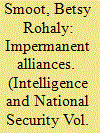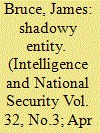| Srl | Item |
| 1 |
ID:
151462


|
|
|
|
|
| Summary/Abstract |
The East Prussian Campaign of August 1914 is famous for the intercept of Russian clear-text radio messages by German radio operators. English language accounts have long credited German radio intelligence with providing the information that brought on the Battle of Gumbinnen. However, German and Russian language documents and accounts tell a different story. This paper argues that radio intelligence did not provide the information that led to the Battle of Gumbinnen. Instead, the origins, conduct and aftermath of the battle resulted from intelligence errors that caused the German command authorities to misunderstand the location, structure and intentions of the opposing Russian forces.
|
|
|
|
|
|
|
|
|
|
|
|
|
|
|
|
| 2 |
ID:
151463


|
|
|
|
|
| Summary/Abstract |
The story of recovery German codebooks from the wreckage of German light cruiser Magdeburg by Russian Navy and the latter use of these books by Royal Navy are widely known. What the Russians were doing with their copies of codebooks has not been thoroughly covered in English. This article deals with elaborate SIGINT system on the Baltic Sea during WWI and especially the heart of it – Sipthamn SIGINT station. There in the middle of woods in current Estonian territory was situated the first radio station in world with intelligence as its primary function. Decryption efforts were directed by Ernst Vetterlein who left Russia 1918 to become a leading cryptologist on Russian direction in the British GC&CS.
|
|
|
|
|
|
|
|
|
|
|
|
|
|
|
|
| 3 |
ID:
151467


|
|
|
|
|
| Summary/Abstract |
The extent of practical cooperation in the business of communications intelligence and communications security between the United States, France, and the United Kingdom on the Western Front has not been documented in depth. This paper will examine cryptologic cooperation between the three allies during the First World War, discuss why the relationships ended after that war, and argue that these impermanent alliances did not shape the cryptologic relationship between the U.S. and the UK that formed during the Second World War.
|
|
|
|
|
|
|
|
|
|
|
|
|
|
|
|
| 4 |
ID:
151465


|
|
|
|
|
| Summary/Abstract |
Revisionist historians of the Western Front have demonstrated that Britain had no alternative but to wage a war of attrition to defeat Germany. However, the effort to assess this process has been neglected in the historiography. This article explores British attempts to gauge the success of their strategy of wearing down German manpower. Efforts in London proved unable to supply a convincing answer. Using General Headquarters’ dubious estimates from the front, Field Marshal Sir Douglas Haig argued that his strategy was working. Prime Minister David Lloyd George’s inability to confound these estimates shaped his decision to permit the Passchendaele offensive.
|
|
|
|
|
|
|
|
|
|
|
|
|
|
|
|
| 5 |
ID:
151466


|
|
|
|
|
| Summary/Abstract |
The Commonwealth assaults against German forces on the western front during 1917 include several famous disasters and successes. Perhaps the least known of these successes is the battle of Hill 70 of August 1917, in which the Canadian Corps seized a powerful German position, inflicted disproportionate and heavy losses on the defenders, and achieved their strategic objective of pinning German forces away from the campaign in Flanders. This success occurred because the Canadian Corps developed a sophisticated and powerful system for set piece battles, in which intelligence played a key role. This article assesses how intelligence affected all aspects of this battle – from national and theatre level decision-making, down to the dissemination of information to individual soldiers. It demonstrates how intelligence worked in tactical and operational terms on the western front in 1917, and shaped battles.
|
|
|
|
|
|
|
|
|
|
|
|
|
|
|
|
| 6 |
ID:
151464


|
|
|
|
|
| Summary/Abstract |
Although the part played by the British War Office’s cryptanalytic bureau in diplomatic cryptanalysis during the First World War is better understood than formerly, its contribution to military Communications Intelligence (Comint) has remained largely unknown. This article describes the origins of what eventually became M.I.1(b), its wartime development as a military cryptanalytic (and eventually cryptologic) bureau, and its post-war demise; it also seeks to identify the factors that contributed to its subsequent obscurity. It concludes that M.I.1(b) played a key role in British army Comint during the First World War, both through its own cryptanalytic work and in supporting and coordinating the efforts of widely dispersed field cryptanalytic activities, and that its subsequent obscurity has served to distort understanding of the development of British Comint.
|
|
|
|
|
|
|
|
|
|
|
|
|
|
|
|
| 7 |
ID:
151468


|
|
|
|
|
| Summary/Abstract |
Historians and practitioners generally date the origins of modern American intelligence to the Office of Strategic Services (1942–1945) and the National Security Act of 1947 which created the CIA and the U.S. Intelligence Community. These claims are CIA-centric and focus on interagency structures. However, modern American intelligence actually has deeper roots of a cultural nature. An observable American intelligence culture was in place by the end of World War I. Not all the aspects of this culture were unique to the United States and, of course, cultures change over time. However, all of the components of early American intelligence culture discussed here are observable in today’s Intelligence Community.
|
|
|
|
|
|
|
|
|
|
|
|
|
|
|
|